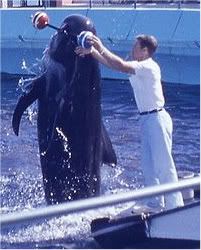 It occurred to me that many of you don’t know my background and I’ve been procrastinating about sharing it–who cares?
It occurred to me that many of you don’t know my background and I’ve been procrastinating about sharing it–who cares?
Guess I was wrong. People do care and lately people who have only known me a few years have been floored at my credentials and my experiences.
So, I’ll be writing my history slowly and you’ll be able to find it filed under the About page.
Believe it or not, my professional career with animals really began early in my teens.
However, animals always gravitated to me from the time I was a young child and I too them. Bubbles the pilot whale in the picture to your left was the star in one of my favorite shows at Marineland of the Pacific–not far from where I grew up.
The varieties of my animal pals were not limited to the domestic critters that lived throughout the neighborhood since they also include the wild creatures that roamed the fields, cliffs, and ocean realm of my home town of San Pedro, California.
As a child, I suffered from allergies (and still do with some species) and so we didn’t have many long-term pets. This was agony for me and my parents kept trying new types of critters to see what might work–there were purebred animals to those with mixed heritage but none got to stay too long.
It wasn’t a small problem because I landed in the hospital on more than one occasion.
However animals found me anyway, and I also managed to forge relationships with all the critters in the area—wild and tame.
I bring up the allergies to point out that you can have an animal career despite challenges.
Originally I thought I would go into marine biology and a niche career of marine mammal work—but although my path started there—it has meandered through many different agencies, countries, and so I’ve worked in many roles with all creatures not just the marine types.
Professionally I claim a career launch with graduation from high school—however it began several years earlier as my love for the ocean grew.
My passion manifested as a love with surfing and educating intercity kids about grunion, the tide pool life, whales and other marine animals.
We lived on the cliffs above the Pacific Ocean and although I traveled up and down the coast to surf, I spent many hours (and years) around the cliffs, on the beaches, and in the sea surround my home town.
Luckily I lived in an area with some unique animal facilities and somehow began volunteering for an agency that educated people about the ocean and life within and around it.
I found myself on the beach and on the ocean on a daily basis and was narrating whale watch tours during a time when the United States was still hunting whales–and when people thought whales were fish. Marine aquariums and oceanariums were new ventures.
Okay, okay, I am dating myself—but with age comes wisdom—remember?
My passion and enthusiasm had to be tempered as the kids often got too excited and the other volunteers had trouble keeping their charges interested since they wanted to know what my groups were doing…try as they might…they couldn’t. That same passion remains with me to this day.
Because I was so active and dedicated, the director of the program approached me (at the urging of his staff) to alert me to a position at Marineland, a marine park that used to be on the Palos Verdes Peninsula—which was an area where we also perched annually to conduct a census of the then endangered Pacific gray whale (Eschrichtius robustus).
Gray whales are mammals that filter feed from the ocean floor. They dredge the sand for amphipods (shrimp-like creatures) and other bottom-dwelling organisms eating by filtering with baleen, a fringed plate that lines the upper jaw.
The Pacific population of gray whales has the longest migration of any mammal, traveling an estimate 10,000 miles (16,000 km) round trip between summer feeding grounds of the Bering and Chuchki Seas in Alaska and the winter breeding and calving grounds in Baja California.
The trip takes about four months and the whales stay close to the coastline, swimming along or in small groups. The migration is staggered according to age and sex. Pregnant females lead, followed by other females, adult males, and then youngsters of both genders.
I jumped at the chance. When I showed up for my interview with tons of other applicants—I was the only teen in a white fashionable suit instead of jeans.
Needless to say I got the job…and that is when things began to get interesting.
In the old school, we teach through story and don’t spell it out.
There are a few lessons in this story. Did you catch them all?
If not, let me help you out. (I won’t be doing this all the time but I need you to catch the subtleties.)
Is an animal career for you?
You’ll know if:
You have a passion that carries you along.
You find a way to get involved with critters whether it pays or not.
Your actions lead you to new opportunities that you explore wholeheartedly.
So, can you answer those questions? I’d like to see some of you share your answers in the comments below.

